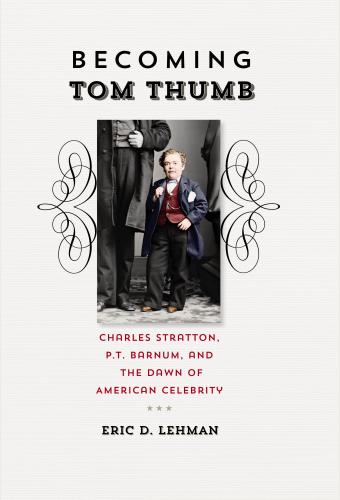Becoming Tom Thumb
| ADRIFTLESS CONNECTICUT SERIES BOOKThis book is a 2013 selection in the Driftless Connecticut Series, for an outstanding book in any field on a Connecticut topic or written by a Connecticut author. |
| Becoming Tom Thumb | |
| CHARLES STRATTON, | |
| P. T. BARNUM, AND | |
| THE DAWN OF | |
| AMERICAN CELEBRITY | |
| Eric D. Lehman | |
| WESLEYAN UNIVERSITY PRESSMiddletown, Connecticut |
| WESLEYAN UNIVERSITY PRESS | ||
| Middletown CT 06459 | ||
| www.wesleyan.edu/wespress | ||
| © 2013 Eric D. Lehman | ||
| All rights reserved | ||
| Manufactured in the United States of America | ||
| Designed by Richard Hendel | ||
| Typeset in Miller, Rosewood, and Poplar by Tseng Information Systems, Inc. | ||
| The Driftless Connecticut Series is funded by the Beatrice Fox Auerbach Foundation Fund at the Hartford Foundation for Public Giving. | ||
| Wesleyan University Press is a member of the Green Press Initiative. The paper used in this book meets their minimum requirement for recycled paper. | ||
| Library of Congress Cataloging-in-Publication Data available upon request | ||
| 5 4 3 2 1 | ||
| Cover image: Charles Stratton (with William B. Harrison). Photograph from the Library of Congress. |
Prologue: Playing the Palace 1
Buttons, Bullfights, and Balloons 49
A Marriage and Two Funerals 185
“The name of no living individual, big or little, is better or more widely known than that of General Tom Thumb.” This declaration on a local promotional advertisement for Barnum’s “Greatest Show on Earth” seems to be simple marketing strategy, until we begin to find this judgment everywhere, from different pens and different voices, throughout the middle decades of the nineteenth century. On his death in 1883, the Daily Los Angeles Herald said, “General Tom was probably better known than any man in the United States.”1 The Herald emphatically used the word “man” and not “midget” or “dwarf” or any other qualifier. This was no accident. Charles Stratton, better known by his stage name of General Tom Thumb, was by almost any standard the most popular performer of the century.
He also may have been America’s first international celebrity. Before Charles, our “celebrities” were primarily politicians or warriors, writers or mystics, and were usually regional rather than national. The only international figures were statesmen like Benjamin Franklin and Thomas Jefferson, and in certain circles writers like James Fenimore Cooper or Washington Irving. Occasionally, the title of our first celebrity goes to William “Buffalo Bill” Cody, who found a worldwide audience at the end of the nineteenth century, but more often someone from the twentieth century takes the prize.2 We tend to think that celebrity began then, in the age of film and recorded music, but it obviously did not.
The use of “celebrity” goes all the way back to the Latin word celebritatem, meaning famous or “thronged.” People in eighteenth-century England often used it to mean something close to temporary interest, rather than the eternal achievement of fame. However, it was used as an adjective, in describing someone as “celebrated” or in one case, of philosopher David Hume describing Jean Jacques Rousseau’s behavior as “an act to gain celebrity.” Its use as a noun describing a person whose attributes and behaviors added up to a famous persona, a “celebrated person, a public character,” appeared first in the Oxford English Dictionary in 1849 and grew in usage throughout the rest of the century.3 “Tom Thumb” rose to prominence just a few years earlier. However, despite the word’s increasing usage, the application is partially retroactive, in the sense that we use it today to refer to anyone who is famous, and thus anyone who was famous in history. No one would have called Queen Victoria a celebrity at the time, but the methods in which she was promoted, the way in which she interacted with the public, and the audience reactions to her fame seem to modern eyes to clearly fit the established pattern.
Whatever designation we give them, actors, dancers, poets, and singers in different cultures throughout history have often achieved the type of renown and adoration we reserve for the movie, television, and recording stars of today. However, in the
